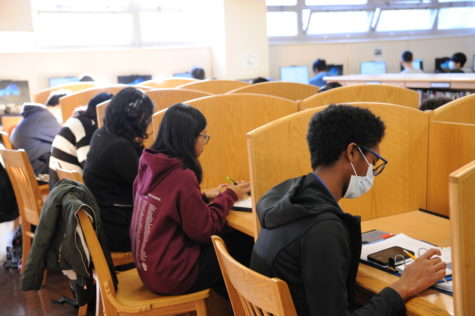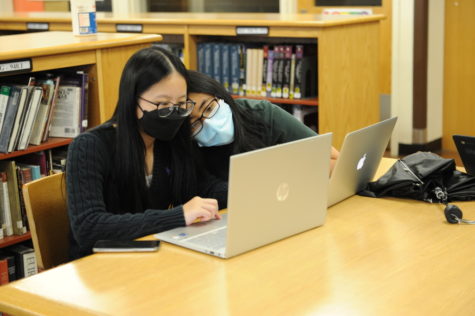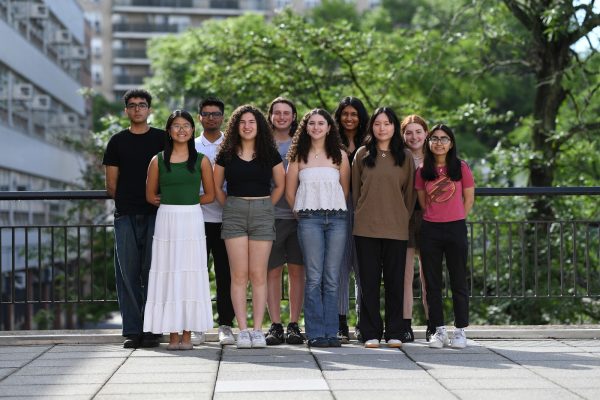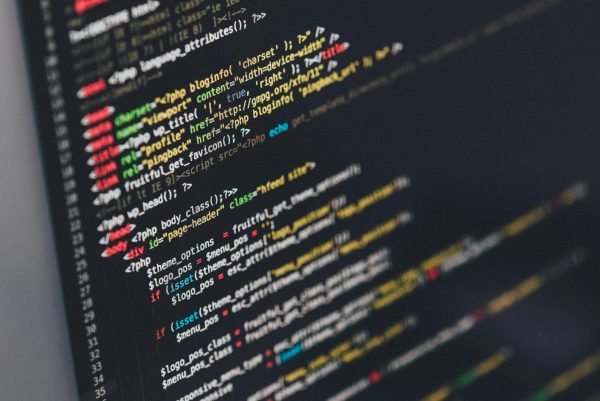After a Three Year Pandemic Hiatus, Uniform MidYear Exams Are Back at Bronx Science
While many Bronx Science students view the return of MidYears with trepidation, many faculty members assert that they are a powerful tool to help students to boost performance on Final exams, Advanced Placement exams, and Regents exams, and that the benefits outweigh the increased stress.
The Bronx Science library is where most students will study during free periods for their Uniform MidYear Exams. Here, two Bronx Science students review course material together.
For many high schoolers, the month of January may bring a new year and the hope of snow days, but for Bronx Science students, it ushers in a time of stress and studying. After four solid weeks of academics between Thanksgiving break in late November and Winter break in late December, jam-packed with tests, projects, and quizzes, even a full week off from school in late December does not fully relieve the pressure felt by students. From the moment that students return to school in early January, they know that right around the corner, starting on January 23rd, 2023, are the notorious, stress-inducing Uniform MidYear Exams.
This January 2023, many Bronx Science students have little idea as to what to expect with this year’s Uniform MidYear Exams. Last year in Januar 2022, due to a winter COVID-19 Omicron spike, midyears were canceled just a few weeks before they were scheduled, in order to help students navigate through that difficult time. The year prior, in January 2021, school was fully remote for all students due to the COVID-19 pandemic, so Uniform MidYear Exams were not given, as there was no way to do so. (Individual teachers gave their own assessments, but they were not Uniform MidYears.) The only true veterans of the Uniform Mid-Year Exams are the current class of 2023 seniors, although their ninth-grade experience with taking these exams may be foggy. Consequently, most of our 2,949 students are heading into the Uniform MidYear week not fully knowing what to expect, feeling a mixture of nerves and stress, but also hope, knowing that their teachers have prepared them to do well on these exams.
Pros and Cons
Nevertheless, Uniform MidYears are not generally welcomed with open arms amongst many Bronx Science students. Bronx Science is a Specialized High School and, as such, strives to challenge its students, Uniform MidYear Exams included.
Ms. Danielle Heckman-Perez, one of Bronx Science’s two Social Workers, reflected on her own experience with these exams as a student. She said, “I always viewed Uniform MidYears like finals. I expected them to be just as hard. I never sat back and thought, ‘It’s going to be pretty chill this year, and I’ll just ramp up on finals.’ You get out what you put in.”
In a survey that I conducted with students for this article, only one of twenty students agreed that Bronx Science should continue with Uniform MidYear Exams. Students cited several reasons for their opposition.
Eimi Matsuda ’25 said, “I don’t think Uniform MidYears are necessary. There are too many tests across the board. Putting another major assessment at the end of January is an added stressor for students.”
The students surveyed wondered why they needed more tests when they already have classroom assessments every week. Testing anxiety is far from unique to Bronx Science. According to studies conducted by Pew Social Trends, finals and midterms are the primary source of stress for one-third of college and high school students across the country.
The Uniform MidYear Exams at Bronx Science are cumulative, and the goal from a pedagogical perspective is to ensure that students have a strong general understanding of the course material midway through the academic year. The goal is for students to have a solid foundation of understanding before transitioning to new content in the next semester. Mr. Bausili, a tenth grade Bronx Science English teacher, said, “The Uniform MidYears are not meant to be difficult. In principle, teachers should have all covered enough of the material on the exam by now for all students to answer competently. The teachers aren’t looking to trip up the students.”
Even with the added stressors and pressure, Uniform MidYear Exams have been known to be a grade booster for many students. In certain classes, when students excel on a Uniform MidYear Exam, their scores replace their lowest test grade from the fall semester. For classes that also take the New York State Regents exams in June 2023, the Regents will do the same for tests in the Spring semester.
This can be crucial, as one failing grade can drag down a student’s overall subject grade. Elize Jonchere ’25 said, “Despite popular belief, Uniform MidYear Exams can be quite helpful in boosting your grades, or at least that’s what I’ve heard from seniors. A lot of my friends and sophomores disagree, but we have never had Uniform MidYears, so I don’t think we really know.” However, Uniform MidYear Exams cannot replace grades of zero, so if students have cheated, skipped a test entirely, or neglected to make it up, or answered every question incorrectly, there is little recourse.
Some teachers give their own in-class ‘midyear’ exams, but the Uniform MidYear Exams are exactly that – uniform – given to all students in all sections of a given class at the same time. The same exams are given to students, regardless of their teacher or class section. Teachers come together to create each Uniform MidYear exam for a given course, making sure that every class has covered the same topics. The benefit to students is that if you have a more difficult teacher, the Uniform MidYear exam is likely much easier than other in-class tests that you take with that teacher. This may cause stress among students if they fear their own particular teacher has left them unprepared, but at Bronx Science, teachers along with the Assistant Principals of each academic department who oversee the process, work hard to ensure that all students are prepared for these exams.
This uniform aspect can be beneficial for teachers, allowing them to see how their own students compare to colleagues’ students, as they are all tested on the same material. Mr. Colin Morrell, Assistant Principal of Physical Science and Engineering at Bronx Science, said, “Uniform Midyears allow us to get a read on how all of our students across classes are doing in a course, so that we, as teachers, can evaluate the results and change course or reevaluate our instruction, if needed, in order to make sure that we are targeting the areas where our students need support the most.” This type of data gleaned from Uniform MidYear Exams allows teachers to implement new lessons or to learn new teaching methods from colleagues whose students fared especially well, in order to adequately prepare all students for end-of-year finals in June.
Similarly, some students find the prospect of Uniform MidYear exams to be less daunting. Charlotte Zhou ’24 said, “I am not too nervous about Uniform MidYear exams. I was really anxious last year leading up to them before they were canceled at the last minute. This year, I feel that the exams will be easier, especially considering that they are created by all members of a given department, which are less focused on actual specifics taught by a specific teacher, as is the case with an in-class exam.”
Additionally, for students taking one or more of the 28 Advanced Placement classes on offer at Bronx Science, Uniform MidYear Exams can not only help students as they learn material but can also give students some real testing experience modeled after the actual Advanced Placement exams they will take in May 2023. The format of Uniform MidYear Exams for Advanced Placement classes adheres closely to the actual format of their respective Advanced Placement exams. The only difference is that the actual A.P. Exams are three hours long, whereas Uniform MidYears only last an hour and a half.
However, it remains unclear as to whether taking Uniform MidYear Exams will affect students’ final exam scores. Last year, when Uniform MidYears were canceled, it did not seem to affect performance on students’ finals exams in June 2022. Principal M. Rachel Hoyle, whom I interviewed for this article, said, “In some courses, we saw some lower Regents scores, and in others, there was less of an effect. Nothing was drastic.” She added, “If anything, the stress around Regents was higher for students, as they did not have that midyear check-in.”
Also, Uniform MidYear Exams and final exams are proven to boost information retention. A study published in the National Library of Medicine found cumulative exams are shown to increase knowledge retention. This is because once you study something, and then wait a period of time and study again, your brain processes the information, and is more likely to hold on to that information long-term.

Testing Jitters
High-pressure testing is a skill, and Uniform MidYear Exams provide a high-stakes environment for students to practice their study habits, time management skills, and testing strategies, all in order to help them to mitigate testing anxiety.
Many students struggle with high-pressure testing anxiety, which is heightened by not having had the practice of taking Uniform MidYear exams over the past three years. All students who have Individualized Education Plans on file do receive extra time to take the Uniform MidYear Exams, but most students do not have such accommodations. For students who struggle with an inability to focus during exams in general, Uniform MidYear exams present an added challenge.
Ms. Heckman-Perez advises students to meet with their Guidance Counselors to learn and to discuss studying and test-taking tips, as well as mindfulness exercises. A common testing tip is called “5, 4, 3, 2, 1.” When feeling stress, take a moment, and identify five things you can see, four things you can touch, three things you can hear, two that you can smell, and one that you can taste. This can help ground you in the present moment and direct your attention back to the task.
Mr. Nasser, Assistant Principal of Guidance at Bronx Science, thinks that the anxiety itself is the problem, and that with a calmer attitude, students may be more likely to succeed.
He said, “If we walk into these exams afraid, worried, or thinking that we are doomed, we’re likely not going to do our best. If we reframe our thinking and look at them as an opportunity, to go in there and show your teacher that you’ve learned material and boost your grade, you will succceed.”
Balancing Mental Health With Academic Rigor
After two years with no Uniform MidYear Exams, the return of these exams has been met with new opposition. Le Wang ’25 said, “I have never taken Uniform MidYear Exams before, so I am nervous. I don’t think the potential grade boost offsets the unnecessary time, and mental energy that goes into preparing for the test. I think it’s definitely time for Bronx Science to get rid of Uniform MidYear Exams.”

In recent years, there has been an increasing focus on mental health and reducing anxiety among students across the nation, partially due to the rise in depression and anxiety heightened by the ongoing Coronavirus pandemic. However, this new emphasis is at odds with most of the spirit and intensity of Bronx Science. Bronx Science has remained rigorous and challenging as a Specialized High School, and some students still feel burdened with tests and homework.
In order to help, Bronx Science has made a concerted push over the past few years to prioritize students’ mental health and well being. The Guidance Department and the Student Organization have plenty of initiatives such as the ‘Zen Den’ and ‘The Twelve Days of Coping’ events, which aim to give students an outlet to relax and de-stress.
However, some faculty members assert that the school can focus on mental health with these initiatives while still pushing students for academic excellence. As Mr. Morrell said, “You don’t need to have exams or good mental health; those aren’t mutually exclusive concepts.” This idea seems to be shared among other Specialized High Schools in New York City. Fellow Specialized High Schools Stuyvesant and Brooklyn Tech are also keeping their Uniform MidYear Exams this year, which occur the same time as at Bronx Science.
Principal Hoyle notes that she hopes that students’ mental health and academic rigor aren’t a tradeoff. She said, “I hope that we encourage promoting mental health in a way where students are still curious, and are able to foster that curiosity, helping to make the rigor more meaningful to students.”
Yet others think the culture of assessments is flawed. Ms. Heckman noted, “I am not a big believer in standardized testing because of the anxiety these tests can cause,” she said. “I don’t think they necessarily give an accurate picture of what someone is capable of under circumstances that are putting them in duress.” Yet she also recognized their importance for preparation for Advanced Placement exams and finals, and for Bronx Science to maintain a strong academic culture.
During the past two years, the number of exams per marking period has decreased from 12 to 10, which Principal Hoyle says “marks a change in the direction.” She also notes that not all assessments are tests, and many may be instead be group projects or academic essays. In other classes, as with classes in World Languages and Mathematics, the knowledge is continuous, so continuous assessments are the best way to track students’ knowledge.
While the Bronx Science Administration has resisted the push to abolish Uniform MidYears entirely, the Uniform MidYears policy was recently adapted. Previously, Uniform MidYears were for almost all major academic classes, but now the policy is that Uniform MidYears are only taken for classes ending in an Advanced Placement or Regents exam. This is especially beneficial for ninth-graders, who now only have to take two midyear exams rather than five. Mr. Nasser said, “I’m pleased with the school’s decision to alter what courses will have a Uniform MidYear. I think that’s been kinder to ninth graders, and it gives them an extra day or two off that week which, for mental health purposes, is a really nice thing.” This change stemmed from an ongoing conversation over a few years, with teachers as a driving force, according to Principal Hoyle. She said, “They have questioned how important Uniform MidYears are, what their role is, and helped us to undertake a general re-examining.”
Mr. Morrell added that more emphasis will be put on preparing ninth-graders with the study skills needed to succeed on high-pressure tests. Generally, when students begin at Bronx Science, it is expected that they know how to study and organize themselves and prepare for tests, but that is often not the case. In middle school, most students have limited experience with spending hours studying for a single class. It is a skill expected to be inherent or one that can be picked up, but many ninth-graders could benefit from more guidance in that area. Bronx Science seems to be on a path to bridge this gap, with lessons on certain skills implemented in ninth-grade courses such as Elements of Engineering, a class that all ninth-graders must take.
Taken together, these changes solidify one thing: Uniform MidYears Exams, in some form, are here to stay, since the Bronx Science Administration and faculty believe that they are beneficial overall. Principal Hoyle said, “I wouldn’t necessarily try to sell students on Uniform MidYears Exams. It’s just something they are going to go through. They will figure out on the backside whether the MidYears were beneficial for them. I clearly think that there is some value in Uniform MidYears Exams, taking in both students’ and teachers’ accounts. I think the ability to contextualize all of your learning as connected comes into play.”
Starting to Study
It may seem daunting to know when and where to start studying, when you have several major Uniform MidYear Exams in one week. The question of when to start studying is a conundrum, especially with other projects and tests that students must complete. Ideally, every student would start studying weeks in advance, but other classroom assignments tend to pile up before Winter break. Among surveyed students, 60% say they planned to start studying for Uniform MidYears Exams over Winter Break, starting after Friday, December 23, 2022.
Bronx Science students and teachers have much advice to offer as to where students should best focus their attention. Stefan Chirinian ’25 said, “Read through Google Classroom and review all of the slides that you’ve gotten on particular lessons that were confusing. For students who are prone to procrastination, just try to sit down and spend a little bit of time studying each day. You’ll be much happier if you do.”
While it may not be easy to just ‘stop procrastinating,’ students are advised to organize themselves before Uniform MidYears Exams. Katia Anastas ’23 said, “Start in advance, organize your notes, and organize yourself. Straighten out your affairs so you aren’t stressed during the week of the exams.” Sela Emery ’23 noted, “Studying can be a good bonding experience, so study with a buddy.”

Other students offer advice regarding focusing your attention differently on each subject. Charlotte Zhou said, “In terms of studying, I think that I study more for the classes that I enjoy and in which I am the most interested. For Mathematics and Physics classes, I recommend studying by just completing a lot of practice problems. For History and English classes, focus more on the larger concepts that were taught.”
The members of the Guidance Department also have their own take, although it may be unpopular. Ms. Heckman said, “I know teachers won’t relent on homework, so when you make a schedule for yourself, you can rationalize and prioritize. Say to yourself, ‘Is my Physics homework more important than failing this Uniform MidYear Exam because I didn’t study?’ We need to be able to rationalize things and say, ‘I can put that to the side and make it up later.’”
It appears that Uniform MidYear exams are here to stay, at least for the foreseeable future. The best advice that teachers and students have is to start studying.
Bronx Science Principal M. Rachel Hoyle notes that she hopes that students’ mental health and academic rigor aren’t a tradeoff. She said, “I hope that we encourage promoting mental health in a way where students are still curious, and are able to foster that curiosity, helping to make the rigor more meaningful to students.”
Liza Greenberg is a Managing Editor and Advisory Editor for ‘The Science Survey.’ She is responsible for editing and her classmates' articles, and...
Isha Ray is a Chief Graphic Designer and People Section Editor for 'The Observatory' yearbook and a Staff Reporter for 'The Science Survey' newspaper....
Susan Cohen is an Editor-in-Chief and Chief Graphic Designer for ‘The Observatory’ yearbook, as well as a Staff Reporter for 'The Science Survey.'...











